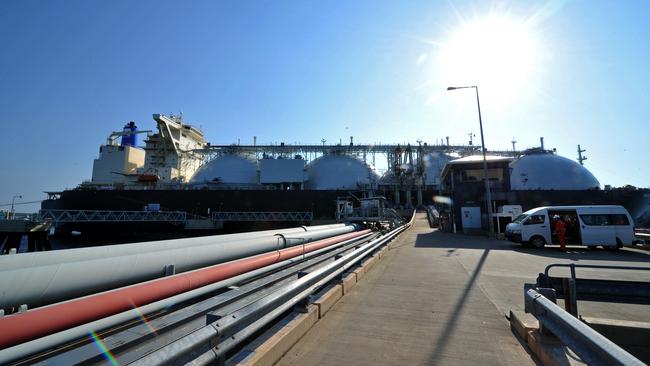Industry calls for action on gas
Big manufacturers have called for urgent gas market intervention to divert east coast exports to domestic users.

The nation’s biggest manufacturers have called for urgent gas market intervention to divert east coast exports to domestic users to ease the impact of what they say is a train wreck that has been years in the making.
As Malcolm Turnbull prepares to meet with the nation’s big gas suppliers in Sydney today, Incitec Pivot chief executive James Fazzino urged the Prime Minister to take action, saying this week’s energy market operator forecasts of a looming gas shortage were evidence of a broken market.
“We’re seeing the train wreck happening before our eyes,” Mr Fazzino, who was this month made chairman of Manufacturing Australia, told Sky Business’s Ticky program last night.
“The short-term solution is to intervene, but the long-term solution is more gas and more gas suppliers.”
An Incitec spokesman said the explosives and fertiliser boss was speaking in his position as chairman of Manufacturing Australia, whose members include Adelaide Brighton, BlueScope, Brickworks, Capral, Cement Australia, CSR, Dulux, Incitec Pivot, Orora and Rheem.
Mr Fazzino said soaring east coast domestic prices for gas while the international price was low showed that the market was not working.
Asked whether this meant he supported gas market intervention, the Incitec chief said: “Yes.The market is broken.”
Separately, the head of agricultural chemicals company Nufarm said surging gas and electricity prices were making it harder to be an Australian manufacturer.
“It just makes our position tougher here against imported products,” chief Greg Hunt said.
“We have got a significant domestic manufacturing base that we are committed to and anything like this (higher energy prices) just makes it harder for us.”
On Monday, the Australian Energy Market Operator warned of a potential 2018 east coast gas shortfall of between 55 and 107 petajoules as it boosted demand expectations and cut domestic gas production forecasts.
The forecasts will inform Mr Turnbull’s decision on whether to use powers to restrict exports out of Gladstone under the recently enacted Australian Domestic Gas Security Mechanism.
The Prime Minister has called gas chiefs to Sydney for a 90-minute meeting in which they will be given a last chance to explain how they can address the shortfall and argue why he should not restrict LNG exports.
Mr Turnbull said the government would commit to ensuring there was no domestic gas shortfall in 2018, effectively indicating the “gas trigger” of diverting exports to the domestic market will be pulled, if gas companies have not addressed the shortfall through other means.
Ahead of the meeting, Santos chief executive Kevin Gallagher said the shortfall should not be just covered by the Gladstone LNG project he operates.
As the only one of three LNG projects at Gladstone that exports more gas than it produces itself, it has been solely targeted by the ADGSM.
But Santos’s claims that it should not be the sole target of intervention have gained traction with Australian Competition & Consumer Commission chairman Rod Sims, who has been commissioned by Scott Morrison to investigate the gas crisis.
Mr Sims has urged the government to target uncontracted, or spot sales, of which GLNG has none.
“Santos will continue to work with industry and our partners to ensure sufficient gas is available to meet domestic demand. However, any forecast shortfall requires an industry-wide solution,” Mr Gallagher said yesterday.
“Santos is committed to ensuring that all of its uncontracted gas is made available to the domestic market at a time of shortfall, on commercial terms.”
Mr Turnbull this week said the government would commit to ensuring there was no domestic gas shortfall in 2018, effectively indicating the “gas trigger” of diverting exports to the domestic market would be pulled then if gas companies had not addressed the shortfall through other means.
The Treasurer yesterday stepped up pressure on the gas producers to divert production onshore, but also targeted the NSW and Victorian governments that ban onshore gas explorations.
“I have no doubt that the industry is more than capable of filling that gap,” Mr Morrison said yesterday.
“What would be even better is if we removed the artificial constraints on gas supply in this country, particularly in the south. In NSW and in Victoria. That is the long-term solution.
“We can do what we need to do in working with the gas companies to get Australian businesses and industry and households the gas they need in the short term by using those mechanisms, but in the long term, what we need is the gas to become available.”
In 2013, Mr Fazzino made a prescient decision to build an $US850 million ammonium plant in Louisiana, rather than Australia, because of what he thought was a better price outlook for gas, the chief ingredient in ammonia.
It has turned out to be the correct decision, with gas in surplus in the US and prices at about $US3 a gigajoule.
In Australia, contracts are being offered around $10 a gigajoule, the ACCC says.
“When we contracted for gas in the US, we had a shortlist of 50,” Mr Fazzino said. “In Australia, you have a shortlist of one.”
Mr Fazzino will retire from Incitec in November, to be replaced by former BP executive Jeanne Johns.
The Australian Pipelines and Gas Association yesterday said that developing a long-term, holistic national energy policy was still key to ensure future energy security.
APGA chief executive Steve Davies said it was tragic that, despite warnings on the looming gas supply shortage over many years, the nation had to reach the brink of a crisis to force action.
“The failure to think strategically and to develop a comprehensive national energy policy has led us inexorably down this path so that the only solution remaining is the drastic one of threatening exports,” Mr Davies said.
Additional reporting: Eli Greenblat

To join the conversation, please log in. Don't have an account? Register
Join the conversation, you are commenting as Logout